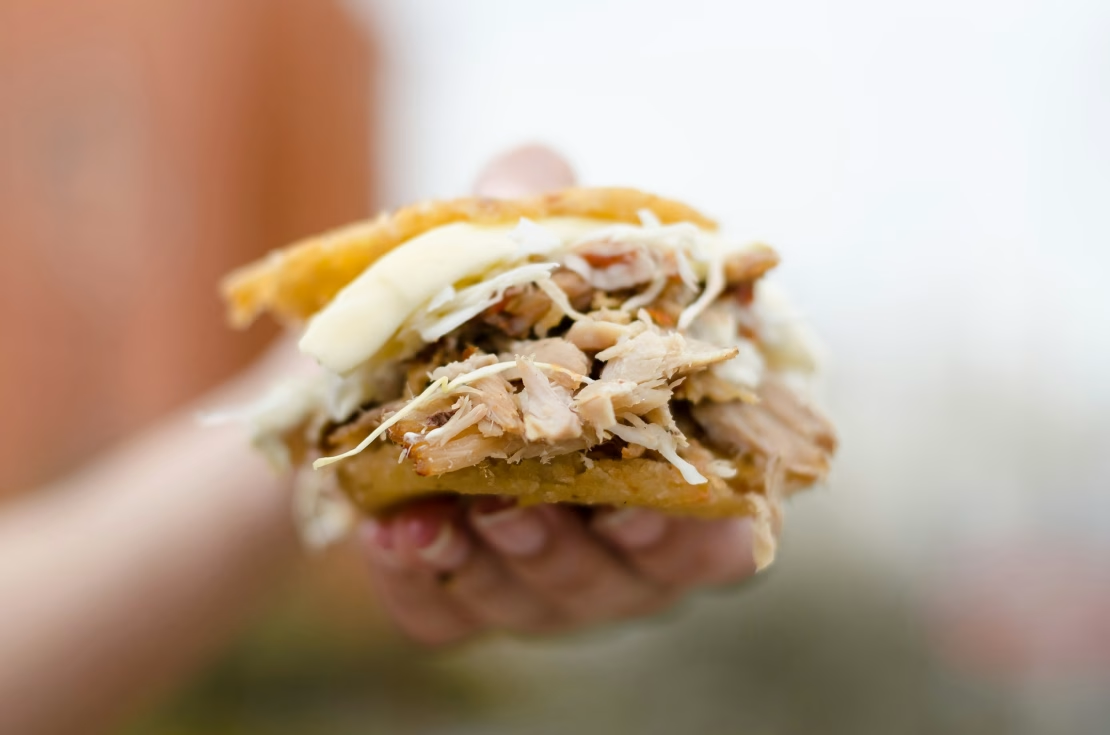Colombian Arepas with Chicken is a beloved traditional dish that showcases the heart of Colombian cuisine.
Made from ground maize dough or precooked cornmeal, arepas are golden, crispy-on-the-outside, soft-on-the-inside corn patties that can be split and stuffed or topped with a variety of fillings.
In this version, juicy, seasoned shredded chicken—simmered with garlic, onions, tomatoes, and aromatic spices—is served either stuffed inside or layered over the arepa for a hearty, flavor-packed experience.
Popular as breakfast, lunch, or dinner, this dish highlights the rustic charm and culinary depth of Colombia’s diverse regions.
Table of Contents
Ingredients
For the Arepas:
- 2 cups precooked white or yellow cornmeal (Harina P.A.N. preferred)
- 2 ½ cups warm water
- 1 tsp salt
- 1 tbsp butter (optional, for extra flavor)
- Vegetable oil or butter for frying or grilling
For the Chicken Filling:
- 2 boneless, skinless chicken breasts (or thighs)
- 4 cups chicken broth or water
- 1 medium onion, finely chopped
- 1 garlic clove, minced
- 1 medium tomato, finely chopped
- 1 tbsp tomato paste
- 1 tsp ground cumin
- ½ tsp smoked paprika
- 1 tbsp vegetable oil
- Salt and pepper to taste
- Fresh cilantro, chopped (for garnish)
Serves
Serves 4–6 people
Step-by-Step Instructions
1. Prepare the Arepas Dough
- In a large bowl, combine warm water and salt.
- Gradually add the cornmeal, stirring with a wooden spoon or hands to incorporate.
- Let the mixture rest for 5 minutes to hydrate the cornmeal.
- Knead the dough until smooth. Add butter if using.
- Divide the dough into 6–8 equal portions and shape into flat, round disks about ½-inch thick.
2. Cook the Arepas
- Heat a skillet or griddle over medium heat and grease lightly with oil or butter.
- Cook the arepas for 5–7 minutes on each side until golden brown and crispy.
- Optional: Finish in a preheated oven at 375°F (190°C) for 10 minutes for a crispier exterior and fluffy center.
- Keep warm while you prepare the chicken.
3. Cook and Shred the Chicken
- In a medium pot, place chicken and cover with broth or water.
- Bring to a boil, reduce heat, and simmer for 20 minutes or until cooked through.
- Remove the chicken, let it cool slightly, and shred using two forks. Set aside.
4. Make the Chicken Filling
- In a skillet, heat oil over medium heat.
- Add chopped onion and sauté for 2–3 minutes until translucent.
- Add garlic and cook for another minute.
- Stir in tomato, tomato paste, cumin, and paprika. Cook until the tomatoes break down.
- Add the shredded chicken, season with salt and pepper, and stir to coat in the sauce.
- Cook for another 5–7 minutes, allowing flavors to meld. Garnish with cilantro.
5. Assemble the Arepas
- Stuffed Arepas: Slice each arepa open like a pita, fill with the chicken mixture.
- Topped Arepas: Place an arepa on a plate and heap the chicken filling on top.
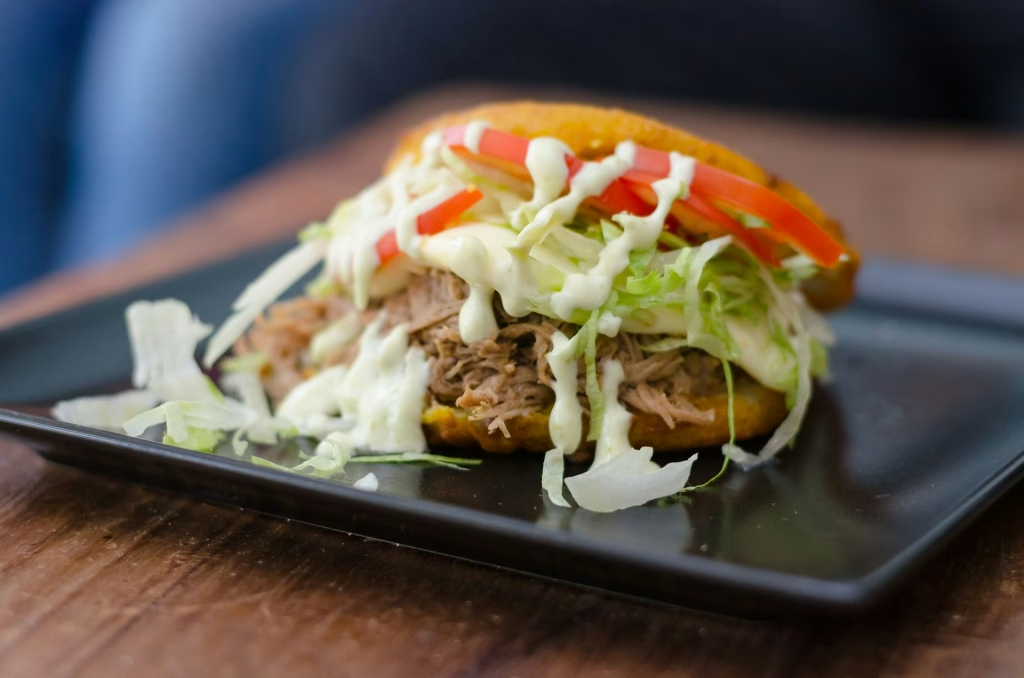
Serving Suggestions
- With Aji Sauce: Serve with Colombian aji picante—a tangy, spicy salsa made with cilantro, green onions, lime, and vinegar.
- With Cheese: Add shredded mozzarella or queso fresco to the filling.
- With Avocado: A few slices of ripe avocado add creaminess.
- Breakfast Style: Add a fried egg on top for a protein-packed start.
- Side Dish: Serve with a side of beans or fried plantains for a full Colombian-style meal.
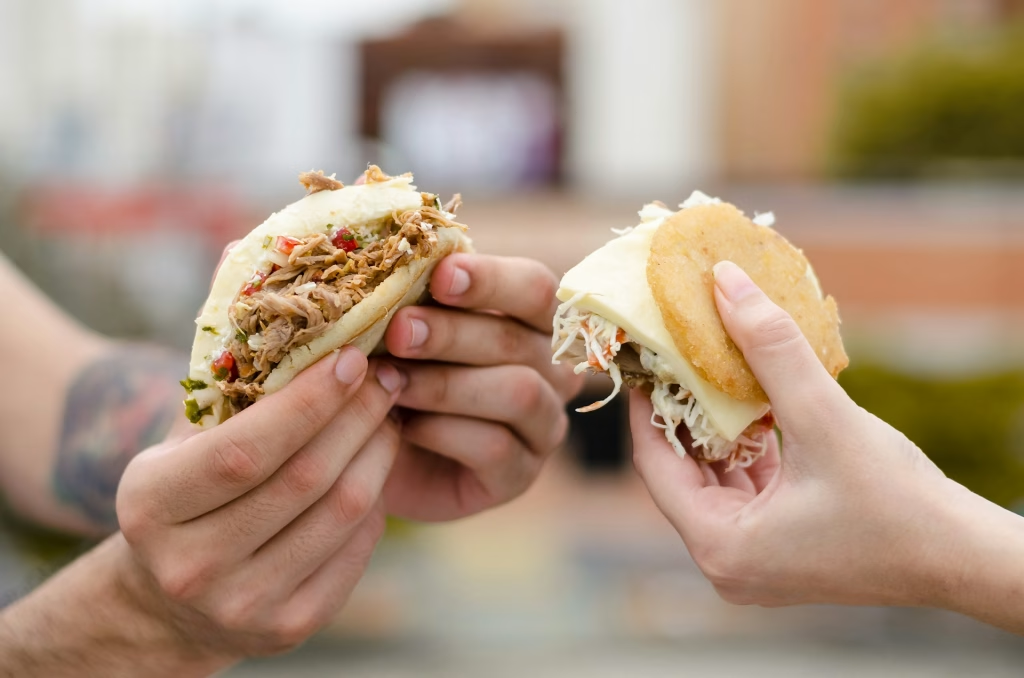
Tips for Perfect Arepas with Chicken
- Hydration Matters: Let the dough rest after mixing so the cornmeal fully absorbs the water.
- Consistency: Dough should be soft but not sticky. Adjust with water or cornmeal as needed.
- Crisp Exterior: Use a hot skillet or finish in the oven to get a golden crust.
- Shred the Chicken Well: Use two forks or a mixer to get fine, tender shreds.
- Build Flavor in the Filling: Simmering chicken in tomatoes and spices enhances taste.
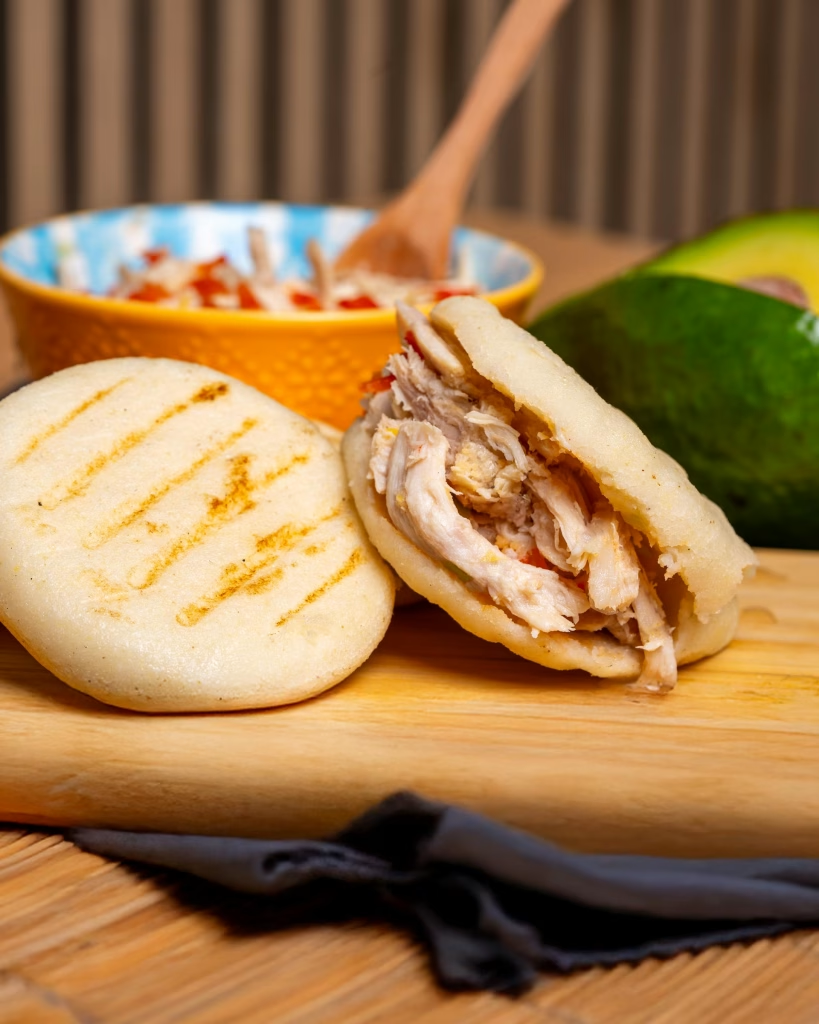
Healthier Alternatives
- Use Chicken Breast: Lean and high-protein with lower fat.
- Grill Arepas: Instead of frying, grill or bake arepas for fewer calories.
- Skip Butter: Make arepas without butter to cut saturated fat.
- Add Veggies: Include shredded carrots, spinach, or bell peppers in the chicken filling for added nutrients.
- Whole-Grain Arepas: Use whole-grain cornmeal if available for added fiber.
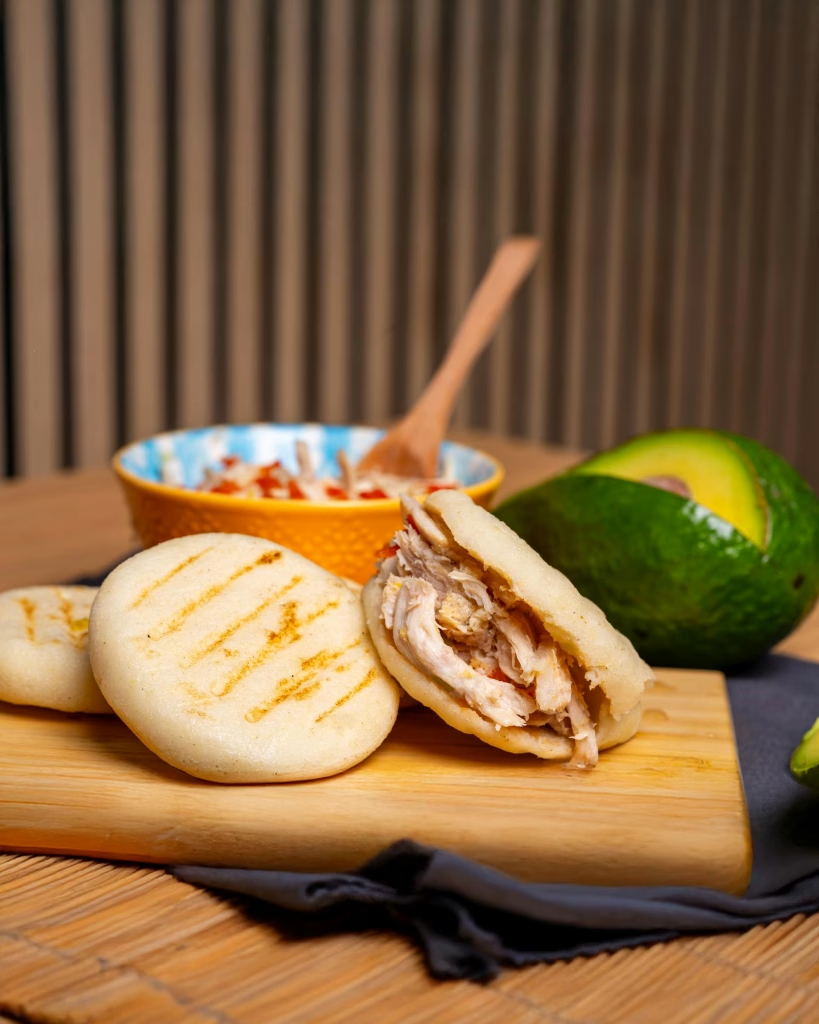
Creative Variations
- Arepas Rellenas: Fill with a mix of chicken and cheese or black beans.
- Spicy Chicken: Add chili flakes, jalapeños, or a dash of hot sauce to the filling.
- BBQ Chicken Arepas: Toss shredded chicken in BBQ sauce for a Colombian-American twist.
- Creamy Chicken: Stir in a little cream cheese or sour cream to make a creamy filling.
- Mini Arepas: Make bite-sized versions for appetizers or party platters.
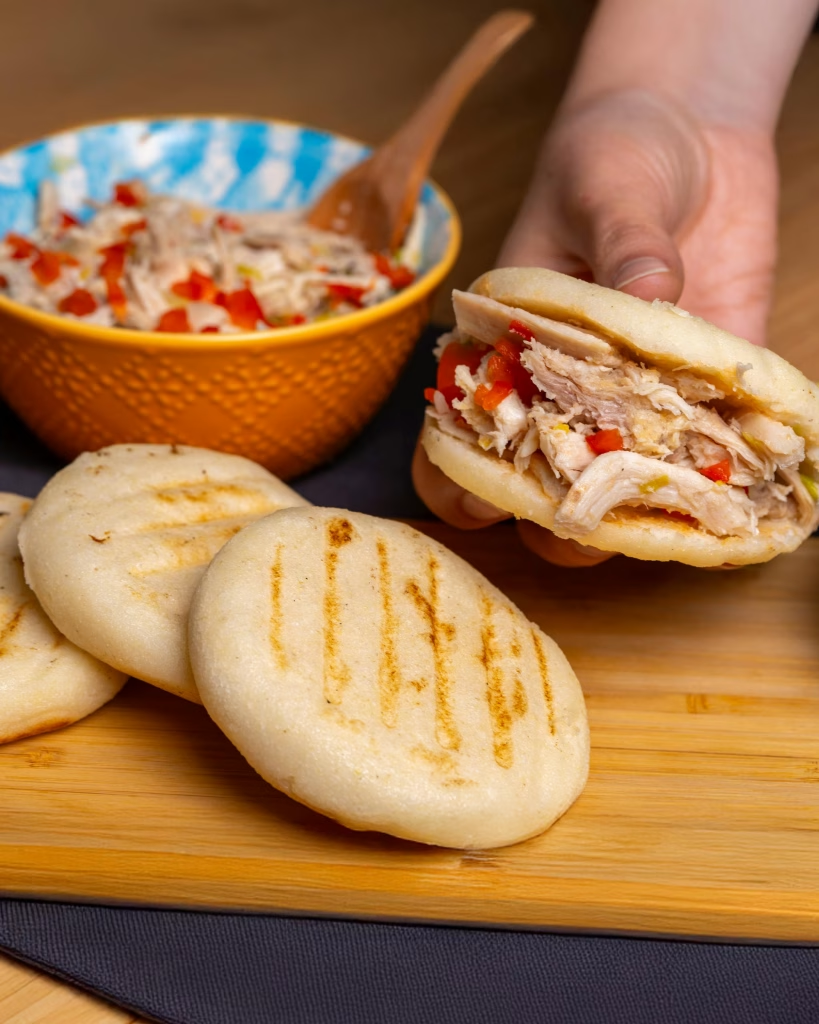
Common Mistakes to Avoid
- Using Regular Cornmeal: Only use precooked cornmeal (like Harina P.A.N.); others won’t work properly.
- Skipping Rest Time for Dough: The dough won’t hydrate properly without a short rest.
- Too Thick or Too Thin: Arepas should be about ½ inch thick for the right texture.
- Undercooking: Raw arepas are doughy; ensure golden, firm crusts.
- Overloading with Filling: If stuffing, don’t overfill or they may split.
- Bland Chicken: Season generously—under-seasoned filling can fall flat.
- Dry Arepas: Cover arepas with a damp towel if not serving immediately to retain moisture.
- Crowding the Pan: Cook in batches for even browning.
- Stale Arepas: Best enjoyed fresh—leftovers can be reheated but not stored for too long.
- Wrong Water Temperature: Use warm—not hot—water to make dough pliable.
History of Colombian Arepas with Chicken
Arepas are an ancient staple of Colombian and Venezuelan cuisine, dating back to the indigenous peoples of northern South America. Long before European colonization, maize was ground by hand and cooked over fire into flat cakes. These early arepas were essential for daily nourishment and religious rituals.
In Colombia, arepas evolved regionally. The country boasts over 70 variations, from the white arepas of Bogotá to the cheese-filled ones of Antioquia. In coastal and Andean regions, arepas are often topped with savory additions. The combination of Arepas with Chicken likely became popular as chicken farming grew and provided an accessible, protein-rich topping or stuffing.
Today, Colombian Arepas with Chicken are enjoyed across households, restaurants, and street vendors. They’re a perfect symbol of Colombia’s agricultural abundance and culinary ingenuity—where simplicity and versatility meet flavor and tradition.
FAQs about Colombian Arepas with Chicken
1. What kind of cornmeal do I use for arepas?
Use precooked cornmeal such as Harina P.A.N. Regular cornmeal won’t work.
2. Can I make the arepas ahead of time?
Yes, cook them and store in the fridge for 3–4 days. Reheat in the oven or skillet.
3. Can I bake the arepas instead of frying?
Absolutely. Bake at 375°F (190°C) for 20 minutes, flipping halfway.
4. How do I know if the dough is the right consistency?
It should feel like soft playdough—not dry or sticky.
5. Can I freeze arepas?
Yes. Freeze cooked arepas in a sealed bag and reheat in a toaster or oven.
6. Can I use leftover rotisserie chicken?
Yes, shred and season it well with sautéed onions, garlic, and spices.
7. Are arepas gluten-free?
Yes, traditional arepas made with 100% cornmeal are naturally gluten-free.
8. What sauces go well with arepas?
Aji picante, avocado sauce, garlic mayo, or spicy chimichurri are all great options.
9. Can I stuff the arepas before cooking?
It’s better to slice and stuff after cooking, as stuffing before can lead to leaks or uneven cooking.
10. What’s the difference between Colombian and Venezuelan arepas?
Colombian arepas are often thinner and used as a base or side, while Venezuelan arepas are thicker and usually stuffed.
Colombian Arepas with Chicken embody the soulful, homestyle cooking of Colombia—simple ingredients transformed into something deeply comforting and satisfying. Whether you serve them for breakfast with a fresh juice or for dinner alongside beans and plantains, these arepas offer a versatile canvas for your creativity. Packed with flavor, easy to customize, and steeped in centuries of culinary tradition, this dish is a must-try for any food lover exploring Latin American cuisine. Whether you go traditional or take a modern twist, one thing is guaranteed—each bite will transport you straight to the heart of Colombia.


